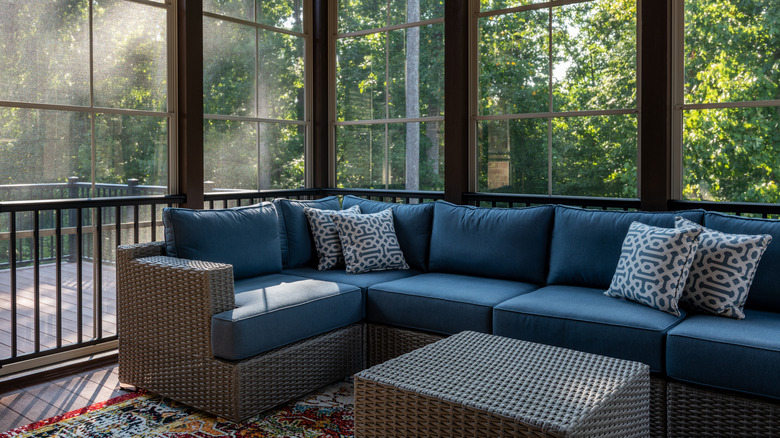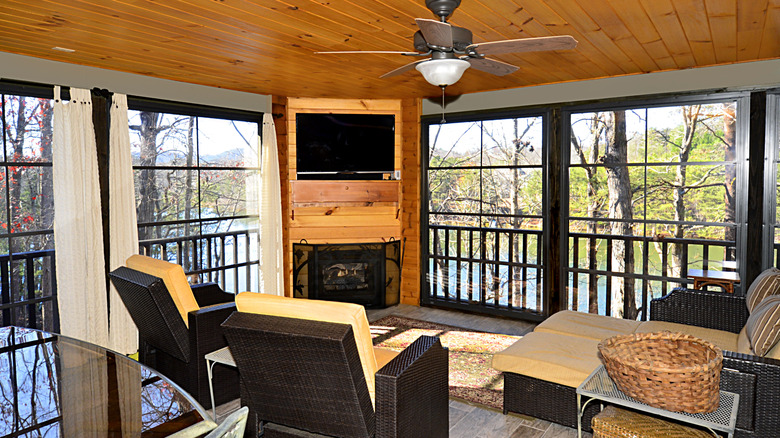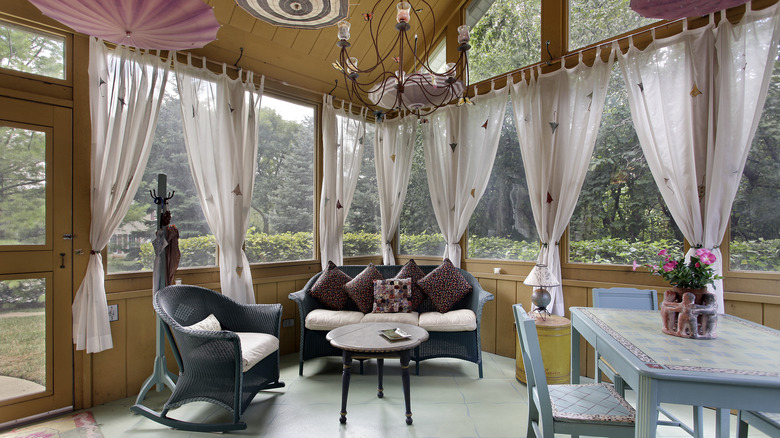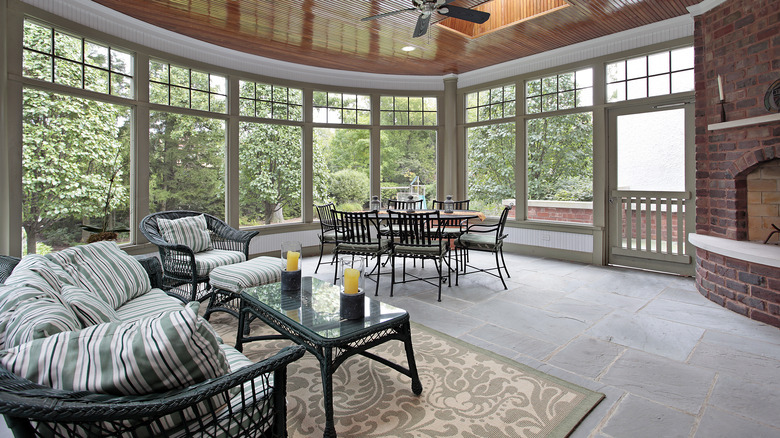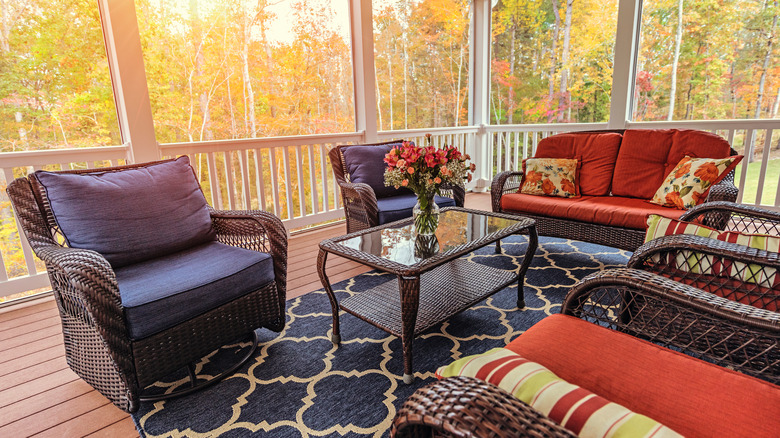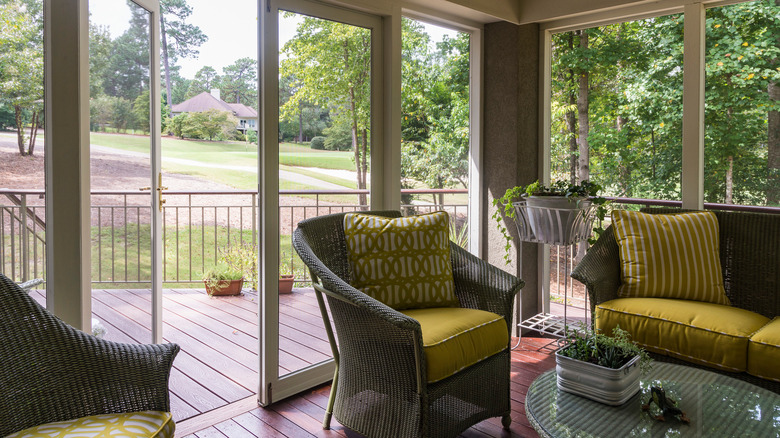5 Savvy Ways To Prep Your Screened-In Porch For Winter
A screened porch is just the perfect space to enjoy the outside without having to worry about bugs or neighborhood rodents. But that's not all, according to Sierra Structure, it might also increase your home value because it's considered an extra living space in your home. During the warmer seasons, you don't really need to do much for your screened-in porch. Any debris and dirt that is stuck on the mesh can be easily wiped away with a damp cloth. Essentially, a screened porch is perfect for most of the seasons but certainly not for all 12 months.
As we're approaching the last quarter of the year, winter is just around the corner, and your screened porch needs all the help it can get to brave the cold winter temperatures. Winterizing your screened porch not only gives you the luxury of using your porch year-round but will also save you a lot on unnecessary energy bills from energy loss. The best time to winterize your porch is as close to winter as possible. Meanwhile, begin by taking measurements and assembling what you need early enough. So how do you prepare your screened porch for winter? Here are a few steps you can follow to get it done properly.
1. Install vinyl sheets
Installing vinyl film over your screened porch is a brilliant way of keeping the cold outside while allowing you to make good of your porch during winter. What's more, installing a vinyl film will not compromise your viewing experience, which is the whole point of sitting outdoors on the porch. So before installing this sheet, you'll need to assemble a few necessities; for instance, a razor, enough vinyl sheets, and non-permanent velcro tape. Since you had taken measurements before, you don't need to do it again, but it's always a good idea to add one or two inches to your original measurement for installation.
However, before installation, you'll need to clear any dirt or debris on the screen fabric. While the vinyl sheets are clear, too much dirt may get in the way of your viewing experiences when outdoors on the patio. While installing vinyl sheets over your screened patio is relatively affordable, you should be aware that thinner sheets might be noisy. However, according to the Empress of Dirt, the thicker alternatives are better because they barely rattle even with strong winds. Also, the shiny appearance might not be appealing to everyone. It's also worth mentioning that installing vinyl sheets is time-consuming and getting more than a pair of hands on deck will be quite helpful.
2. Install heavy-duty vinyl curtains
Another simple approach to winterizing your screened patio is using heavy-duty vinyl curtains. Similar to vinyl sheets, they're also quite affordable and are great for keeping heat indoors. Installation is also quite simple, you'll only require a few tools like tension rods, and if customizing the vinyl fabric to size, a grommet tool. Since every patio is built differently, you'll need to take measurements from wall to wall, to know exactly the length of the rods you will require.
You should also factor in a pulley system that will allow you to roll the curtain up and down whenever necessary. There is no doubt that the vinyl curtains will go a long way in keeping the patio functional even during winter. In fact, they make heat regulation in your patio possible regardless of the temperature outside, notes the Enclosure Guy. Another fascinating thing about these curtains is that they come in a variety of colors and styles perfect for any interior style.
3. Consider installing a fireplace
The ultimate luxurious touch you can add to your porch that will also go a long way in making the space cozy during winter is installing a fireplace. Starting a fire creates just the perfect environment for cozying up with friends and family during the frigid winter temperatures. However, it's worth mentioning that the type of fireplace you install will depend on how much space you have on your porch. A portable fireplace is ideal, especially if you have a smaller porch with limited space to spare.
When choosing a fireplace for your screened patio, it's important to put into consideration how the structure will fit into your existing outdoor decor. Fortunately, there are plenty of fireplace designs for almost any style. Remember, installing the wrong fireplace will mean that you have to live through the winter looking at the unsightly design that you wished you never had. If you're the frugal type, you'll be delighted to know that installing a patio fireplace doesn't need to break the bank. According to Home Advisor, the cost of installing an outdoor fireplace ranges from $1,500 to $20,000. You can easily find one that is within your budget.
4. Bring in the heat
If you don't have room for a fireplace, don't find a new chill spot this winter just yet. One way of making the porch cozy enough during winter is by bringing in an alternative source of heat. There are plenty of ways of heating up your patio area, for instance, wall, floor, and standalone space heaters. Usually, floor heaters are built into the existing flooring so they might not be ideal for everyone. Wall heaters, on the other hand, can provide heating continuously; however, some smart options will only heat the space when the temperature drops from a set value.
The final option, which is also the most common among homeowners, is the stand-alone space heaters. They can be set up virtually anywhere on the patio or even in other rooms, depending on your needs. Infrared standalone heaters are quite effective for heating up the patio. They're not only energy-efficient but are also environmentally friendly (via Newair). You'll also be delighted to find out that they're also available in several styles and price ranges, depending on your budget.
5. Weatherproof the rest of the porch
Now that you've dealt with the major upgrades to your screened porch, it's time to turn your attention to the smaller details that often fly under the radar. Inspect the entire structure for small cracks, gaps, and holes. You'll be surprised just how much heat loss is caused by these small crevices on the screen fabric or even the door. Fixing the cracks on the screen fabric is quite easy, all you need is waterproof caulk and that should be it. Door seals, on the other hand, wear off over time and the frame also expands, creating small gaps that contribute to energy loss.
For this reason, weatherproofing doors should be done after a couple of years. So if you haven't done it before, take it as a sign that it's indeed time, advises Trimlite. It's also important to highlight that how fast the weatherstrip on your doors wears out depends on the frequency of use. So before going shopping for a new weather strip, first inspect the current one. Consider replacing the weather strip if there are apparent signs of wear and tear.
